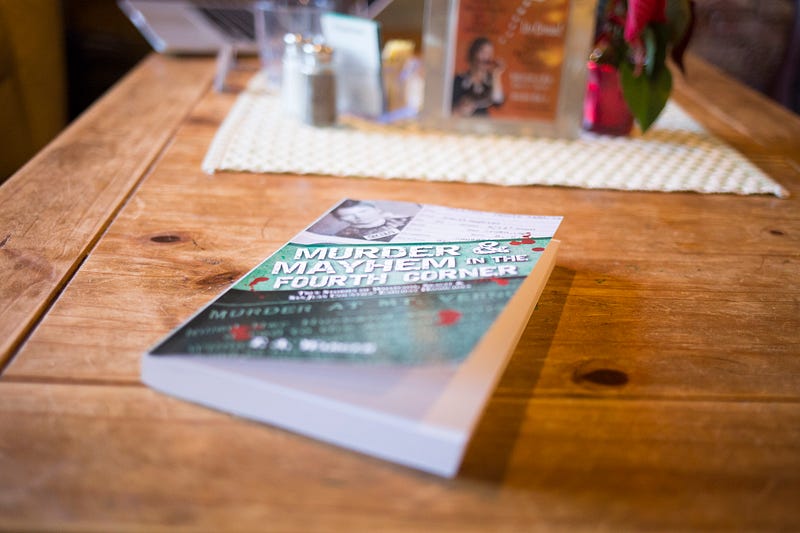The pen and the axe
Historian Todd Warger writes the histories of Whatcom County’s most mysterious and gruesome murders for the community to remember.
Story by EMMA AGTE & Photos by Mathew Roland
People have always been interested in the criminal side of society. It’s what draws neighbors in robes and slippers out on their lawns in the night to see why the cop lights are flashing across the street. Human interest drives curiosity about the morbid and seemingly far away horrors that find their way onto our doorsteps. Todd Warger, local Whatcom County historian, acts on this curiosity. In fact, he writes entire books because of it.
Science has made leaps and bounds in DNA technology in the last 20 years, and as a result, cases are now being solved after they’ve been cold for decades. But for those unsolved cases, especially homicides, where DNA is not available, the only hope of solving the mystery is a continuing dialogue about what community members remember.
The man who wrote the book on crime
Todd Warger’s excitement is evident as he talks about unsolved murders in Whatcom County. Specifically, mysteries from a time before DNA technology existed. Warger specializes in Whatcom and Skagit County history from the beginning of white settlement through the Great Depression — about 1850 until 1930. His favorite thing to research from this time? Unsolved murders. He digs up the evidence and compiles tales of local people who were tragically killed.
As long as his books are on shelves, people can keep talking about these cases and remember the Whatcom County residents who met an untimely ending in what was then an even quieter town.
The server at the Colophon Café knows Warger by name and takes a seat with him at the end of her shift, legs outstretched after a day on her feet. He spends hours here researching and writing his books. He loves stories — even the ones where nobody dies.

Strange Research
Warger’s just released his third book on unsolved murders during this time, “Murder and Mayhem in the Fourth Corner,” in late November. All three books detail the historic unsolved mysteries of Whatcom County, some of which took place in Bellingham homes.
As he collected these stories, Warger saw a strange sort of local history start to emerge. These murders outlined the transient lifestyles of men coming through the area in search of gold. They traced the dangerous transport of opium down the Puget Sound and the conflicts brought along with prohibition. It describes an incompetent, by Warger’s standard, but well-meaning sheriff’s department dealing with a blind horse roaming downtown one day and a brutal decapitation the next.
“People, for whatever reasons, don’t look at these fringe histories,” Warger said. “Some historians may think it’s a taboo subject. I certainly think it’s a window into the culture and spotlights a historical period of time.”
One of the earliest murders detailed in Warger’s second book, “More Murder in the Fourth Corner,” occurred in 1858 on Lummi Island where two men were shot in the head at close range, presumably because they were on the island in search of gold. Hannah Jones, an environmental science student and true-crime fanatic said reading Warger’s books gives her a better sense of what Whatcom County was like 100 years ago.
“It was particularly interesting to find out from reading [Warger’s] book that the Fraser River gold rush had just as many sort of sinister cultural impacts as it did environmental impacts on the area,” Jones said.
Aside from writing books on murder, Warger works for the Whatcom Museum and co-authored a book called “Images of America: Mount Baker” and created an Emmy Award nominated documentary called “The Mountain Runners” about a 1911 mountain and endurance race on Mount Baker. Warger spends hours combing through old newspapers as part of his research.
“Going through the microfilm of the old papers, you find these salacious headlines and stories,” he said. “I would print it off and stuff them into a folder and think ‘you know, one of these days I’ll get back [to it].’”
But even after tucking the bits and pieces of paper away, the cases never leave Warger’s mind. He is constantly thinking, what was the motivation? What could the sheriff have missed? What is the connection between victim and perpetrator that may be missing? Sometimes the perfect piece to complete the backdrop of a story comes from family members or newly discovered headlines, but sometimes the answers arise in a more undertone fashion. Warger will discover something seemingly unrelated like divorce proceeding records, and this will shed light on the character of a suspect or victim and provide an intimate look into the workings of their personal life. Research from the strangest of places can provide some of the best context for these stories, Warger said.
Filling the Niche
The compelling nature of mystery leads Warger to look deeper into these cases. However, the same scarcity of information that excites him is also the greatest hurdle in the research process. Warger once drove to Olympia to view someone’s prior criminal record, looking to shed some light on a domestic murder case he was researching. When he reached the file it was almost completely empty. A small note reading “This file has been pulled” was all that remained in the light-yellow folder.
Some murders remain too shrouded in mystery for Warger to complete the story. He’d rather wait for an entire picture to develop than rush a story to publication before it is completed. He said he feels trapped between feelings of responsibility, one to the victim who deserves to have their story told, and another to the research, which must be complete to tell a true story.
Fellow local historian and author Rustan Robertson praised Wagner’s commitment to the stories he writes.
“I just have such respect for Todd and what he’s doing because every one of those stories that he’s now published could so easily have been just lost in history and never seen again,” Robertson said. “To have people be able to learn and understand the legacy of those stories [means they] can now live on.”
Community Matters
Every table was full on Halloween night at The Vault, a wine bar in Blaine. The owner of the bar Alan Finston clinked a large ovular wine glass to introduce Warger.
Warger held a legal pad and took up his corner of the low-lit room, filled with rough wood and industrial lighting. The medium-built man with short greying hair and the beard of someone who keeps long hours addressed the crowd.
The room chuckled and grimaced along with the twists and turns of former Blaine residents’ stories. He talked of a revered and fiercely independent woman, Addie Roper, who was murdered in Blaine in 1907. An intruder waited in her home and struck her on the head with an axe when she got home then doused the room with kerosene, setting the entire house ablaze. Warger ended his story on a cliffhanger, telling attendees to come talk to him at the bar if they want to hear the surprise ending. People wandered over, wine in hand, gossiping as if these cases happened yesterday.
Warger often finds himself connecting with the community in odd ways. Taboo topics lead to taboo conversations. Nothing is off limits when you write about murder, he said.

Once, after a reading from his first book, a local woman came up and asked if Warger had heard of a murder suicide that occurred in 1919. She referenced murder victim Orpha “Wilder” McGuire, her great aunt. Warger recognized the details and had collected an article or two about the murder. The woman wanted her family member’s full story to be told and felt that Warger was the man to do it.
Within the next week, Warger encountered a woman after his reading who also wanted him to look in to a family murder. She told Warger she felt it wasn’t appropriate for someone in the family to write the story, but that she had a great aunt who was killed in a murder suicide in Blaine. Warger asked if the murder occurred in 1919.
“I said ‘I was just talking to your cousin last week,’” he said.“It turned out this family split after a gruesome murder and these are two second cousins that live here and never have seen each other.”
Moving Forward in Time
Whatcom County Sheriff Bill Elfo has asked Warger to write about more recent unsolved murders to bring them to the front of the community’s mind. One of the most requested stories is the “yacht club murder,” which happened in Bellingham in 1960. Some people claim there was a coverup and the murderer’s identity is known among a handful of people in the community.
“I got a copy of the whole police file and I can tell you right now something stinks,” Warger said.
However, he sticks to late 19th and early 20th century crimes to avoid causing further harm to those affected by the murders.
While there are books and articles on serial killers who came through Washington, Warger said stories like the Hillside Strangler murders don’t touch on the local impact they had.
“It doesn’t talk about how it affected the area at that time. Bellingham was still a small community and it was descended upon by media,” Warger said. “Even when you go reading books on the subject, you can have a 600-page book and you’ve got like 28 pages dedicated to Bellingham.”
His third book on the topic “Murder and Mayhem in the Fourth Corner” was released in November 2018. Technically the murders in this book stretch into Skagit County, but at the time this area was considered part of Whatcom County.
His stories of yore can tell us as much about Bellingham’s social workings as more current cases can and perpetuating the culture of talking and thinking about cold cases can help lead to a final solution.
